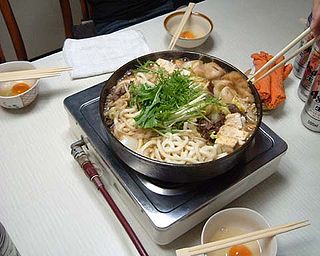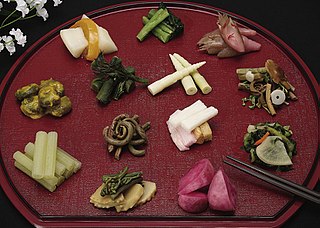
Miso is a traditional Japanese seasoning. It is a thick paste produced by fermenting soybeans with salt and kōji and sometimes rice, barley, seaweed, or other ingredients. It is used for sauces and spreads, pickling vegetables, fish, or meats, and mixing with dashi soup stock to serve as miso soup, a Japanese culinary staple. Miso is high in protein and rich in vitamins and minerals, and it played an important nutritional role in feudal Japan. Miso is still widely used in both traditional and modern cooking in Japan and has been gaining worldwide interest.

In cooking, a sauce is a liquid, cream, or semi-solid food, served on or used in preparing other foods. Most sauces are not normally consumed by themselves; they add flavor, moisture, and visual appeal to a dish. Sauce is a French word taken from the Latin salsa, meaning salted. Possibly the oldest recorded European sauce is garum, the fish sauce used by the Ancient Romans, while doubanjiang, the Chinese soy bean paste is mentioned in Rites of Zhou in the 3rd century BC.

A condiment is a preparation that is added to food, typically after cooking, to impart a specific flavor, to enhance the flavor, or to complement the dish. A table condiment or table sauce is more specifically a condiment that is served separately from the food and is added to taste by the diner.

Oden is a type of nabemono, consisting of several ingredients such as boiled eggs, daikon, konjac, and processed fishcakes stewed in a light, soy-flavored dashi broth.

Nabemono, or simply nabe, is a variety of Japanese hot pot dishes, also known as one pot dishes and "things in a pot".

Sumbala or soumbala is a fermented seed condiment used widely across West Africa. It is usually prepared by women over the course of several days, traditionally from 'néré seeds. It can be made from other kinds of seeds, such as those of Prosopis africana, and the use of soybeans for this purpose is increasing due mainly to inadequate supply of néré seeds. It is comparable to miso paste.

Karashi, also known as Oni Karashi is a type of mustard used as a condiment or as a seasoning in Japanese cuisine. Karashi is made from the crushed seeds of Brassica juncea and is usually sold in either powder or paste form. Karashi in powder form is prepared by mixing with lukewarm water to a paste and leaving it covered for a few minutes.

Fermented bean paste is a category of fermented foods typically made from ground soybeans, which are indigenous to the cuisines of East, South and Southeast Asia. In some cases, such as the production of miso, other varieties of beans, such as broad beans, may also be used.

Instant soup is a type of soup designed for fast and simple preparation. Some are homemade, and some are mass-produced on an industrial scale and treated in various ways to preserve them. A wide variety of types, styles and flavors of instant soups exist. Commercial instant soups are usually dried or dehydrated, canned, or treated by freezing.

Mixian is a type of rice noodle from the Yunnan Province, China. It is made from ordinary non-glutinous rice, and it is generally sold fresh rather than dried.

Nimono is a simmered dish in Japanese cuisine. A nimono generally consists of a base ingredient simmered in shiru stock & seasoned with sake, soy sauce, and a small amount of sweetening. The nimono is simmered in the shiru over a period of time until the liquid is absorbed into the base ingredient or evaporated. The base ingredient for a nimono is typically a vegetable, fish, seafood, or tofu, or some combination of these. The shiru stock for a nimono is generally dashi. Other than sake and soy sauce, the stock can be further flavored by mirin, sugar, salt, vinegar, miso, or other condiments.

Yuzu koshō is a type of Japanese seasoning. It is a paste made from chili peppers, yuzu peel and salt, which is then allowed to ferment. It is usually used as a condiment for nabemono dishes, miso soup, and sashimi. The most famous types of yuzukoshō come from Kyushu, where it is a local specialty.

Kushikatsu (串カツ), also known as kushiage (串揚げ), is a Japanese dish of deep-fried skewered meat and vegetables. In Japanese, kushi (串) refers to the skewers used while katsu means a deep-fried cutlet of meat.

Tsukemono are Japanese preserved vegetables. They are served with rice as an okazu, with drinks as an otsumami (snack), as an accompaniment to or garnish for meals, and as a course in the kaiseki portion of a Japanese tea ceremony.

Beurre maître d'hôtel, also referred to as maître d'hôtel butter, is a type of compound butter of French origin, prepared with butter, parsley, lemon juice, salt and pepper. It is a savory butter that is used on meats such as steak, fish, vegetables and other foods. It may be used in place of a sauce, and can significantly enhance a dish's flavor. Some variations with a sweet flavor exist. It is usually served cold as sliced disks on foods, and is sometimes served as a side condiment.

Anchovy paste is a fish paste food product prepared using anchovies as a primary ingredient. It is used as a condiment and as an ingredient in various dishes, such as Scotch woodcock, and is a mass-produced product. It has been used for centuries to provide flavor to foods and as a source of nutrients, and it is a part of the cuisines of Great Britain, Italy, the Philippines and Vietnam. It is a major export product of Morocco.

















